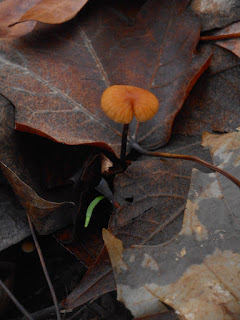Time
– and Water – Do Tell
January
16, 2017
(and
January 20)
The
cold, snow and ice (and “atomic star crystals”) of January 8 did
not last long. Soon, we were back to unseasonably warm weather and
rain, rain, rain.
The
rains did awaken interesting fungi, mosses and lichen, including this
one that I had never seen before:
Cladonia
ochrochlora
Smooth-footed
Powderhorn
 |
| I found it on a rotten chunk of wood on the slope, on my way down to Cottonwood Pond. |
Wood Ear mushroom on the Cottonwood Trunk
Rains
(as well as freezing and thawing) have changed the girth and general
look of the Root Ball over time, as dirt kept falling from it. Dirt
collecting below into piles has changed not only the look but the
dynamics of Cottonwood Pond and nearby spaces.
January 18, 2013 - so much more dirt on the Root Ball, none below, and the pond still an even bowl of water.
2017 - can see the Cove opening at the bottom of the Root Ball, in the middle, between mud piles.
The Cove
2017 - main pond and south edge of Root Ball
Approximately same view in 2013
(notice the Bent Blue Beech arched over the pond and Root Ball)
2017 - Root Ball - top side
I
wondered if the increasing size of the dirt piles was pushing water
farther out, changing the perimeter of Cottonwood Pond.
I
looked at photos from January 18, 2013, and saw that, indeed, that's
what happened. The whole look of the main Pond has almost completely
changed. And look at the difference in the Root Ball!
2013
2017
Mud
Pile #1, near and around the north edge of the Root Ball, was the
first dirt to collect. It definitely changed the flow of water around
that end, creating the Isthmus between the main pond and “little
pond.”
2013 - on the left, water flows very close to the Root Ball between the main pond and "little pond", with a little "dam" in the way.
2013 - "little pond" below the top side of the Root Ball, and the beginning of the little Isthmus on the edge. No Mud Piles yet.
2017 - Isthmus (lower right) going to "little pond" (upper part of photo)
2013 - the little "dam", to become the Isthmus
2017 - "little pond" (foreground), with excess water pushing to the north, the Isthmus (middle) and the main pond (background)
2017 - a closer look of the same - falling dirt from the north edge of the Root Ball, plus piles of rotting autumn leaves, have been building up Mud Pile #1, which used to only be below the Root Ball Bottom, at the edge of the main pond.
The
Seep was definitely flowing. Though it has always headed from the
pond corner to the Creek, its route getting there has changed over
time.
2017 - corner of main pond and beginning of Seep
2013 - where the Seep starts at the western corner of the main pond
2017 - the Seep, as seen from the Creek - flowing from the corner of the main pond
Where the Seep meets the Creek, there is the Bark Ledge, which was completely obscured by fallen leaves. Since then, Seep flow from heavy rains have pushed leaves away.
And
… look how much the Inlet has changed!
2013 - Water seems to be entering the pond only through the far ends of the Inlet, while the center is blocked off by soil (again, notice the Bent Blue Beech above the far end of the pond, over the Inlet.)
The Inlet, at the south end of the main pond, is all clear in 2017
In January, 2017, a channel is evident through the leafy bottom, showing where water had entered the main pond through the Inlet.
2017 - the other side of the Inlet, where water, after heavy rains or snow melt, goes under the Barkless Log, entering the main pond.
The
Bent Blue Beech arching over the south end of the main pond has become
the Broken Blue Beech …
2017
… with
another generation of Blue Beech saplings growing from the base.
Look
at the difference in the Cottonwood Trunk in four years' time! As of
2017, the thick, blocky bark was almost completely gone.
2013 - looking down the north side of the Trunk
2017 - looking down the north side of the Trunk
2013 - looking down the south side of the Trunk
2017 - looking down the south side of the Trunk
2013 - looking up the Cottonwood Trunk
2017 - looking up the Cottonwood Trunk
As
bark fell and time worked on the Trunk, it sported more fungi (whose
mycelium helped break down the wood,) more moss, and more small plant
sprouts (whose roots would work on the wood even more.)
Looking
back four years has shown me how much it has all changed, mostly
through the actions of rain and running water. How will Cottonwood
Pond look four years from this time, in 2021?
January
20, 2017
Four
days later … more warm weather, more rain …


































































































